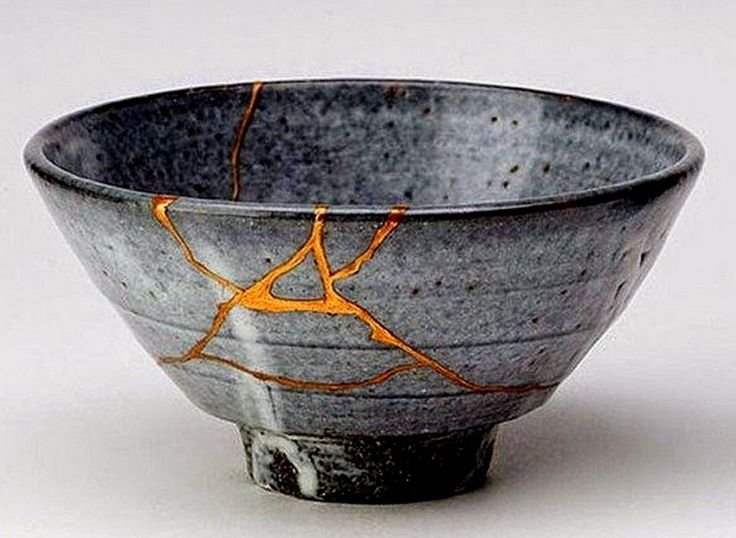Kintsugi The Art Of Creating Beauty From Brokenness
We know that using ceramics over the years will result in some of them chipping or breaking. Rather than discarding the broken cans, the Japanese practice highlights and enhances them, resulting in a beautiful work of art. It is also known as Kintsukuroi, meaning golden ("kin") and to repair ("tsugi"). Traditional Kintsugi involves repairing ceramics with gold and lacquer, leaving a seam of gold where the cracks were. The technique involves joining fragments and giving them a new, refined appearance. As a result of the randomness with which ceramics break and the irregular patterns that are accentuated with metals, each repaired piece is unique. The "scars" in every repaired piece become part of the design, resulting in a unique masterpiece.
Kintsugi, or Kintsukori, dates back to the 15th century, when shogun Ashikaga Yoshimasa, according to legend, broke his favorite chawan, a Chinese ceramic tea bowl, and sent it back to China for repair. They returned and fixed it, but bound it with unsightly metal staples. It inspired him to find an elegant way to modify the ceramics, which led to the invention of Kintsugi. Kintsugi pottery adheres to the Zen ideal of Wabi sabi, the acceptance of imperfection. The act of finding joy in aged, worn objects and appreciating their flaws as their beauty. As well as kintsugi repair, other Japanese expressions include mottainai, which means regretting wasting something, and mushin, which means to free one's mind and accept change.
Kintsugi is far more than just a technique for making repairs; it is a way of thinking, a way of living, and a way of looking at things. Among the Japanese, it is referred to as 'wabi-sabi'. In this worldview, imperfections are embraced. Accepting something is not enough; one must sublimate it, find a way to make it beautiful. It's a beauty built on three pillars: imperfection, impermanence, and incompleteness. The term wabi-sabi cannot be translated literally. As a concept, wabi originally meant the solitude of life in nature, and therefore simple and rustic things. Sabi refers to tranquility, nostalgia, the beauty of time and old age. This philosophy of wabi-sabi is the core of Japanese culture and at the origin of Kintsugi. As important as Greek thought about beauty and perfection is to the West. Thus, Wabi-san, and Kintsugi, become a form of ideal, a road to enlightenment. To this day, Japanese culture is filled with the wisdom of accepting the fatalities of existence and magnifying them.
In tea ceremonies and ceramic art, we find examples of the wabi-san aesthetic at its best. This is where the Japanese art of mending ceramics with gold originated. In Japan, the service of tea is indeed governed by a set of rules and codes. An experienced practitioner is the only one who can conduct this ritual correctly. Patient gestures, calmness, and unfailing silence are necessary. Each object in this ceremony has a symbolic, ritual significance, and the ceramics used for this ceremony are the most significant. Simple, unpretentious, and humble ceramics are ideal for this ceremony. However, connoisseurs know how to see the traces of great craftsmanship in simplicity. In the event that the object breaks one day, there is no question of tossing it. To restore its history and to transcend its cracks, we entrust it to a Japanese craftsman who knows how to mending it with gold.
Kintsugi, the Japanese art of mending ceramics with gold, is a relatively simple technique. This technique derives from maki-e, which is golden lacquer decoration. The ceramic is reassembled with lacquer or resin after it has been broken. By doing this, the broken pieces are reattached together, with minimal overlap. After the lacquer is applied, gold dust is applied that fixes to the lacquer, thus giving the break its golden color. Occasionally, an entire section of ceramic is missing or completely cracked, so a mixture of gold and lacquer is used to cover the whole addition. Nevertheless, the Japanese art of mending ceramics with gold can go even further, as the craftsman may take a piece of another ceramic, which is not the same as the one being repaired, but which has a similar shape. As this piece is then assembled with the original ceramic, a patchwork effect is created as the object acquires an even greater depth and history.
Nowadays, Kintsugi is celebrated throughout the world since it has crossed the boundaries of Japan. Museums such as the Metropolitan Museum in New York, or the Smithsonian have held exhibitions dedicated to the technique. Contemporary artists and designers have examined the method as well. In her fashion designs, Karen Lamonte uses Kintsugi to fix fabrics together. Clearly inspired by Japanese culture, she creates an impressive effect of refinement. Additionally, Charlotte Bailey uses this technique to sublimate vases with the Kintsugi technique. George Inaki Root, a New York designer who created a line of jewelry called Kintsugi using several of the techniques from this tradition, can also be cited. Or Victor Solomon who was inspired by the practices of Kintsugi to repair a fractured basketball court in the south of Los Angeles in 2020. The aim was to evoke the social disintegration taking place in these neighborhoods and also to coincide with the start of the NBA season following the Covid-19 epidemic. The Kintsugi is also very popular with amateurs. The Kintsugi is also very popular with amateurs. Whether it's loss of a loved one, lonely confinement, or the simple desire to understand one's own cracks, there are many reasons for introspection. With the Japanese art of mending ceramics with gold, all of these events become an opportunity to find a sense of comfort and serenity.



